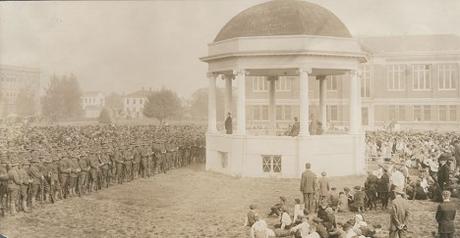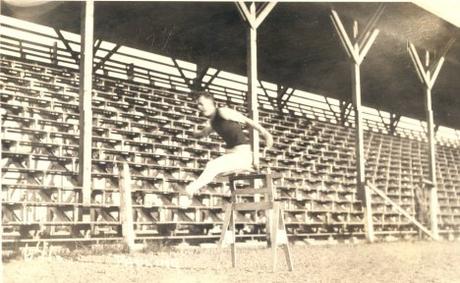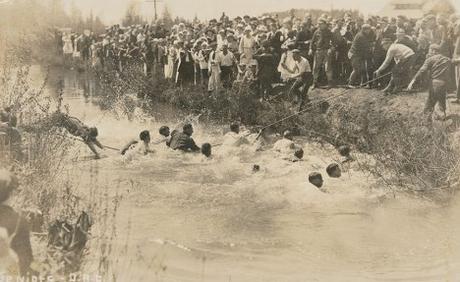
President William Jasper Kerr speaks to members of the Students’ Army Training Corps, as assembled near the OAC bandstand, 1918.
[Part 4 of 4 in our series examining the Oregon Agricultural College that Linus Pauling knew during his freshman year, 1917-1918. Fall 2017 marks the 100th anniversary of Pauling’s enrollment at his undergraduate alma mater, known today as Oregon State University.]
Linus Pauling’s freshman year at Oregon Agricultural was spiced up a bit by a little administrative drama. Beloved OAC President William Jasper Kerr, who been appointed ten years prior in 1907, was being courted by Kansas Agricultural College, at that point the largest “aggie school” in the United States. An “insistent” Kansas board of higher education offered Dr. Kerr the presidency of KAC and a salary of $9,000 per year, compensation far beyond anything that OAC could propose.
The Kansas offer was met with heartfelt concern from OAC’s students, one of whom stated in a Barometer article that “every friend of the College hopes the President may decline the offer.” Of this moment, Pauling later recalled
Directly after I arrived in Corvallis, in the fall of 1917, there was a big rally with a couple of thousand of students marching down to the President’s House, singing songs that had been made up for the occasion, urging him to stay here instead of going to Kansas State College, in Manhattan, Kansas….that was one of my memories of one of the exciting events during my first year.
In December, the campus shared a collective sigh of relief when it became public that Kerr had decided to stay. Speculating about this turn of events, The Barometer suggested that “President Kerr’s decision seems to have been made chiefly on the grounds of the splendid opportunities afforded in Oregon through the cooperation of the able and united forces that have supported his administration.”
Kerr’s presidency would continue for another fifteen years, coming to a close only upon his acceptance of the position of Chancellor of the Oregon State System of Higher Education. His leadership was key to the success of OAC, which grew significantly during his years of service.

Pauling hurdling at Bell Field during his short-lived track career, 1918.
Pauling came away from his first semester of college with five A’s, two B’s, and a D in Mechanical Drawing. (Of Pauling’s one notably poor mark during the term, biographer Tom Hager writes, “he wasn’t patient enough to let the ink dry on his work, Pauling remembered, and kept smudging it.”)
Spring semester for Pauling revolved around a heavy course load that included Integral Calculus, Descriptive Geology, French, and Qualitative Analysis. It was during this semester that he also received his only failing letter grade, the product of an unsuccessful attempt to circumvent the physical education requirement by joining the school track team. His try-out was, evidently, a mess, and he did not make the team. Once this gambit had failed, Pauling chose not to return to the Gym class in which he was enrolled, as his course load was proving to be quite heavy. (He took, and passed, the required class later on during his OAC career.)
Though encumbered by significant responsibilities outside of the classroom – including the lack of a permanent address and the need to work multiple jobs to make ends meet – Pauling completed his first year with seven A’s, one B, and two C’s – one in Descriptive Geometry and the other in Camp Cookery. The grade scale that OAC used at the time included a letter grade “E,” meaning that OAC marks of B, C and D were comparable to contemporary grades of A-, B+, and B-. As such, Pauling’s freshman academic record was really quite superb, both within his major and across the military and liberal arts courses that were required of him.
As Pauling’s academic excellence mounted, so too did the invitations to join a number of honor societies. By the time of his graduation in 1922, Pauling was a member of the Scabbard and Blade military honorary, and had served as secretary of the Sigma Tau engineering honor society, treasurer of the Chemical Engineering Association, and president of the Chi Epsilon civil engineering honor society.

Two OAC classes battle in the tug of war, 1912. The competition was often held at the nearby millrace, with the losing class obliged to take a dip.
Socially, the 1917 school year broadly conformed to the calendars that had defined previous years, though a few changes were necessitated by World War I, particularly during spring semester 1918.
Because a significant portion of the men in the junior and senior class had left campus for Officers’ Training Camp, springtime saw a premature rendition of Junior Weekend. The commencing affair was “Junior Flunk Day,” while other happenings included the “Fresh-Soph Tug-of-War.” Pauling’s class, the freshmen, won this display of strength and, after watching this apparent disgrace, the juniors challenged the seniors and won. Junior Prom followed the tug-of-war and was treated as a sendoff for the young men leaving for the European theater. Previously a formal event, the conditions brought about by war rendered the 1918 Junior Prom more of an informal affair.
Outside of socializing on campus at dances and club events, students in Corvallis often entertained themselves with a night out. Popular activities included seeing movies at the Majestic Theater and ending the night with ice cream at Winkley’s Creamery. Another hot spot for spending time and grabbing a bite to eat was Andrews & Kerr, which served “Hooverized” waffles and offered a location where “seniors enjoyed high jinks.” Pauling was fond of A&K’s and frequented it when he could afford to, especially after seeing a show downtown.
The concluding social activities of the year transpired during Graduation Week and consisted primarily of events tailored to the graduating class. One notable highlight was the Senior Picnic Breakfast at A&K’s, complete with “bacon, coffee, oranges, eggs, buns, and doughnuts.” Other events included the dedication of the class monument and, as post-commencement exercises, an Alumni Ball and Banquet.
Overall, the 1917-1918 school year at Oregon Agricultural College was an eventful and productive one, if shadowed throughout by the specter of war across the Atlantic. The OAC to which Pauling had been introduced was a varied and multifaceted institution, buoyed by an enthusiasm for shaping students into engaged, innovative, and community-oriented citizens. These principles and this spirit left a mark on Linus Pauling, just as he made an impact on the college and, later, the world.
Advertisements